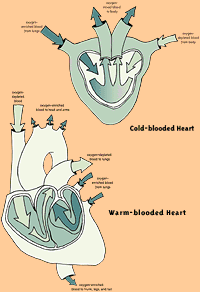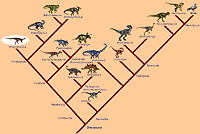Willo FAQ
1. Why
is Willo such an important paleontological discovery?
2. What kind of dinosaur is Willo?
3. Who found it? Where? Who studied it?
4. Where is Willo now?
5. Some people claim Willo’s heart is a “lump of mud” or
an ordinary concretion, not a dinosaur heart. What is a concretion?
6. How could the concretion in Willo's chest contain the
structure of a heart?
7. I've heard that Willo was found in a formation (Hell Creek)
that does not contain the types of sediments in which soft tissue can
be preserved. Is that true?
8. If the identification of the heart was made by doctors,
rather than paleontologists who are familiar with CT scans of fossils,
how could they know what they’re looking at?
9. If it is a four-chambered heart, how does that imply that
the dinosaur was warm-blooded? Don’t some reptiles have four-chambered
hearts?
10. If Willo was warm-blooded, what does that say about
dinosaurian evolution?
11. What research is being carried out on the heart?
12. Are there plans for additional research?
1. Why is Willo such an important
paleontological discovery?
It is the first dinosaur ever found to contain a fossilized heart.
Although soft tissues such as tendons and skin have previously been discovered,
this is first time the structure of an internal organ was so well preserved.
Another notable soft tissue discovery was Scipionyx samniticus,
announced in 1998 by Italian paleontologists. Traces of the intestines,
windpipe, liver, and muscle fibers were preserved in this baby theropod
from the Cretaceous Period. http://www.dinosauria.com/jdp/misc/scipionyx.html
2. What kind of dinosaur is
Willo?
Willo belongs to the Ornithischian, or "bird-hipped" line of dinosaurs.
It is a Thescelosaurus, a plant-eater with teeth like salad tongs,
ideal for browsing vegetation in its riparian forest habitat.
Thescelosaurs lived during the late Cretaceous, and ranged from Wyoming
and the Dakotas northward into Alberta, Canada. The species
is uncertain, but believed to be T. neglectus. It was about 13
feet (4 meters) long and about 665 pounds (300 kg) in the flesh. Its gender
is unknown.

Classification: Ornithischia: Genasauria: Cerapoda: Ornithopoda: Hypsilophodontidae: Genus Thescelosaurus: species probably T. neglectus
Name derivation: Greek theskelos = "marvelous" + sauros ="lizard"
Age: 66 million years old
3. Who found it? Where? Who studied it?
Paleontological investigator Mike Hammer unearthed Willo
in 1993 from the Hell Creek formation in northwestern South Dakota. He
nicknamed the dinosaur after the wife of the rancher on whose property
it was found. Hammer took the fossil to a friend, Dr. Andy Kuzmitz, and
they conducted initial CT scans. The North Carolina Museum of Natural
Sciences in Raleigh purchased the fossil in 1996. Subsequently, the CT
data went to a team made up of Museum and N.C. State University scientists,
who did further research and published their findings in the April 21,
2000 issue of the journal Science.
4. Where is Willo now? 
On exhibit at the North Carolina
Museum of Natural Sciences in Raleigh, N.C.
5. Some people claim Willo’s
heart is a “lump of mud” or an ordinary concretion, not a dinosaur heart.
What is a concretion?
A concretion is a stone-like mass that is usually harder than the sedimentary
rock that surrounds it. The concretion in Willo's chest contains complex
structures, which "lumps of mud" do not.
6. How could the concretion
in Willo's chest contain the structure of a heart?
The concretion has a high concentration of an iron mineral that forms
when little oxygen is present in water. Under these conditions soft tissues
do not decay as rapidly as they otherwise would. Besides
the heart, cartilagenous sternal ribs and plates attached to the ribs,
and possible tendons attached to vertebrae were also preserved.
Given that the heartlike structures are in the correct region of the body,
and of the correct size and orientation for a heart, it is most reasonable
to conclude that they formed from a heart.
7. I've heard that Willo was
found in a formation (Hell Creek) that does not contain the types of sediments
in which soft tissue can be preserved. Is that true?
Soft tissue preservation in findings from the Hell Creek formation
has been reported several times in the scientific literature. In 2000,
blood vessels were identified under similar physical circumstances in
association with the skull of a Triceratops (Journal of Vertebrate Paleontology,
volume 20, supplement to Number 3, p. 47A).
8. If the identification of
the heart was made by doctors, rather than paleontologists who are familiar
with CT scans of fossils, how could they know what they’re looking at?
The initial identification was made by a medical doctor, who showed
the CT scans to a group of heart specialists. He asked them what they
were looking at, and they said, "a heart". Shortly thereafter, a team
from North Carolina that included a comparative anatomist, a paleontologist,
a geochemist, and a computer imaging specialist familar with the appearance
of soft tissues in CT scans reviewed the scans. Months of meticulous inspection
confirmed the original identification of the heart.
 9.
If it is a four-chambered heart, how does that imply
that the dinosaur was warm-blooded? Don’t some reptiles have four-chambered
hearts?
9.
If it is a four-chambered heart, how does that imply
that the dinosaur was warm-blooded? Don’t some reptiles have four-chambered
hearts?
While it is true that some reptiles (alligators and crocodiles) have
four-chambered hearts, Willo's heart has a single systemic aorta, rather
than the double aorta found in crocodilians. Among living animals, this
kind of heart is found only in mammals and birds, which are warm-blooded.
(Illustration
© N.C. Museum of Natural Sciences. Click to see a larger version.)
10. If Willo was warm-blooded,
what does that say about dinosaurian evolution?
Dinosaurian evolution is usually studied from the point of view of documenting
lines of ancestry and descent, much like a family tree, properly called
a cladogram. (Shown below - Click to enlarge)
Evolution can also be studied from the point of view of general changes
occurring more or less simultaneously across many groups. An example of
ancestry/descent would be the origin of birds from small flesh-eating
dinosaurs, and an example of a general trend would be a general increase
in body size in dinosaurs from Triassic through Jurassic time.  The
two major groups of dinosaurs are the lizard-hipped forms, or saurischians,
and the bird hipped forms, or ornithischians. Curiously, it is the saurischians
that have been linked to the ancestry of birds; the ornithischians became
extinct at the end of the dinosaurian era and have no living descendants.
Because birds apparently have always been active animals, by association
the small saurischians (some of which bore filaments or feathers) are
also considered to have had relatively high metabolic rates. Although
some ornithischians had complex grinding teeth and chewed their food to
increase the rate of digestion, there has been relatively little thought
given to the possibility that they might have been transitionally (or
fully) warm blooded, in spite of isotopic evidence supporting the possibility.
However, Willo evidently possessed a heart similar to the heart in living
birds and mammals that are known to be warm-blooded. It thus focuses attention
on a trend in both major groups of dinosaurs toward higher metabolic rates.
Interestingly, mammals and some groups of insects (for example, bees)
were probably attaining higher metabolic rates at the same time. Dinosaurs
were thus participating in a general transition toward higher activity
levels in animals.
The
two major groups of dinosaurs are the lizard-hipped forms, or saurischians,
and the bird hipped forms, or ornithischians. Curiously, it is the saurischians
that have been linked to the ancestry of birds; the ornithischians became
extinct at the end of the dinosaurian era and have no living descendants.
Because birds apparently have always been active animals, by association
the small saurischians (some of which bore filaments or feathers) are
also considered to have had relatively high metabolic rates. Although
some ornithischians had complex grinding teeth and chewed their food to
increase the rate of digestion, there has been relatively little thought
given to the possibility that they might have been transitionally (or
fully) warm blooded, in spite of isotopic evidence supporting the possibility.
However, Willo evidently possessed a heart similar to the heart in living
birds and mammals that are known to be warm-blooded. It thus focuses attention
on a trend in both major groups of dinosaurs toward higher metabolic rates.
Interestingly, mammals and some groups of insects (for example, bees)
were probably attaining higher metabolic rates at the same time. Dinosaurs
were thus participating in a general transition toward higher activity
levels in animals.
11. What research is being
carried out on the heart?
The entire skeleton, including the region of the heart, was rescanned
in September 2000 in greater detail to determine whether smaller structures
are preserved. The site from which the skeleton was excavated was re-examined
to determine under what conditions the dinosaur was buried. The chemistry
of the concretion in the heart region is being compared to other concretions
found near where the skeleton was buried.
12. Are there plans for additional
research?
Plans are being made to study the physical and biological environments
where the skeleton was buried, and to make comparisons with similar environments
in low, wetland forests in North Carolina and elsewhere in the southeastern
United States. The studies will be designed to reveal information on how
heart-like structures could be preserved, as well as on the habitat of
the small dinosaur.